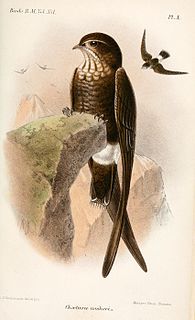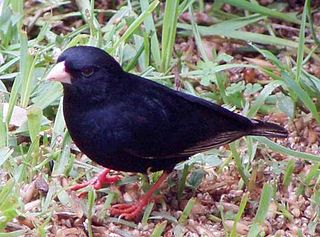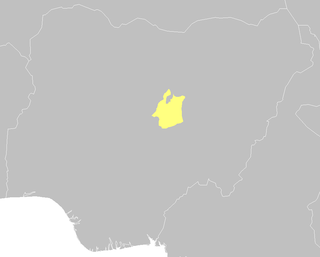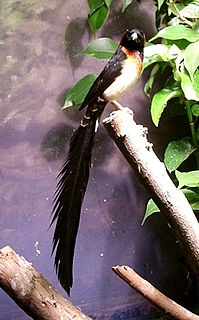
The village indigobird or the steelblue widowfinch is a small songbird belonging to the family Viduidae. It is distinguishable from other indigobird species by bill and leg colours, the colour tinge of the male's breeding plumage, song, and to lesser extent, the nestling's plumage and mouth pattern. The bill colour can be red or white depending on the population, and there is some regional variation in the colour tone of the male's plumage.

The long-tailed paradise whydah or eastern paradise whydah is from the family Viduidae of the order Passeriformes. They are small passerines with short, stubby bills found across Sub-Saharan Africa. They are mostly granivorous and feed on seeds that have ripen and fall on the ground. The ability to distinguish between males and females is quite difficult unless it is breeding season. During this time, the males molt into breeding plumage where they have one distinctive feature which is their long tail. It can grow up to three times longer than its own body or even more. Usually, the whydahs look like ordinary sparrows with short tails during the non-breeding season. In addition, hybridization can occur with these paradise whydahs. Males are able to mimic songs where females can use that to discover their mate. However, there are some cases where females don't use songs to choose their mate but they use either male characteristics like plumages or they can have a shortage of options with song mimicry. Paradise whydahs are brood parasites. They won't destroy the eggs that are originally there but will lay their own eggs in other songbirds nest. Overall, these whydahs are considered least concerned based on the IUCN Red List of threatened species.

Latham's francolin or the forest francolin, is a species of bird in the francolin group of the family Phasianidae. It is the only member of the monotypic genus Peliperdix. It is found in Angola, Cameroon, Central African Republic, Republic of the Congo, Democratic Republic of the Congo, Ivory Coast, Equatorial Guinea, Gabon, Ghana, Guinea, Liberia, Nigeria, Sierra Leone, South Sudan, Tanzania, Togo, and Uganda.

The mottled spinetail is a species of swift in the family Apodidae. It is found in Angola, Benin, Burkina Faso, Cameroon, Central African Republic, Republic of the Congo, Democratic Republic of the Congo, Ivory Coast, Equatorial Guinea, Gabon, Gambia, Ghana, Guinea, Guinea-Bissau, Kenya, Liberia, Malawi, Mali, Mozambique, Niger, Nigeria, Senegal, Sierra Leone, Somalia, South Africa, Tanzania, Togo, Uganda, Zambia, and Zimbabwe.

The cuckoo-finch, also known as the parasitic weaver or cuckoo weaver, is a small passerine bird now placed in the family Viduidae with the indigobirds and whydahs. It occurs in grassland in Africa south of the Sahara. The male is mainly yellow and green while the female is buff with dark streaks. The eggs are laid in the nests of other birds.

The green-headed sunbird is a species of bird in the family Nectariniidae. It is found in Angola, Benin, Burkina Faso, Burundi, Cameroon, Central African Republic, Republic of the Congo, Democratic Republic of the Congo, Ivory Coast, Equatorial Guinea, Gabon, Gambia, Ghana, Guinea, Guinea-Bissau, Kenya, Liberia, Malawi, Mali, Nigeria, Rwanda, Senegal, Sierra Leone, South Sudan, Tanzania, Togo, Uganda, and Zambia.
The Zambezi indigobird, also known as the twinspot indigobird or green indigobird, is a species of bird in the family Viduidae. It is found in Malawi, Tanzania, Zambia, and Zimbabwe.

The dusky indigobird, variable indigobird, or black widowfinch is a species of bird in the family Viduidae. It is found in Angola, Burundi, Cameroon, Republic of the Congo, Democratic Republic of the Congo, Guinea-Bissau, Malawi, Mozambique, Nigeria, Sierra Leone, South Africa, Swaziland, Tanzania, Zambia, and Zimbabwe. Its natural habitat is moist savanna.

The exclamatory paradise whydah or Uelle paradise whydah is a species of bird in the family Viduidae. It is also known as the long-tailed paradise whydah, a name which can refer to Vidua paradisaea.
The barka indigobird is a species of bird in the family Viduidae. It is found in Cameroon, Ethiopia, Gambia, Ghana, Guinea, Nigeria, Sudan, and South Sudan. It is also known as the baka indigobird but the spelling "barka" is more correct; the word is a greeting in the Hausa language.

The Jos Plateau indigobird is a species of bird in the family Viduidae. It is endemic to Nigeria. It lays its eggs in the nest of the rock firefinch which is also restricted to Nigeria. Because of their inability to incubate their eggs, they lay their eggs in the nest of the rock firefinch and then take away the exact number of laid eggs from the host bird in order to avoid suspicion from the host bird. After hatching they exhibit dominance against the hatchlings of the rock firefinchers. Their breeding seasons are all round the year but more pronounced during the cold Harmattan period between July and December.

The broad-tailed paradise whydah is a species of bird in the family Viduidae. It is found woodland and acacia savanna habitat in Sub-Saharan Africa from Angola to Uganda, Tanzania and Mozambique. A brood parasite, it has a wide range and the International Union for Conservation of Nature has assessed it as being of least concern.

The purple indigobird is a species of bird in the family Viduidae. It is also known as the dusky indigobird, a name which can refer to Vidua funerea. It is found in Angola, Botswana, Democratic Republic of the Congo, Kenya, Malawi, Mozambique, South Africa, Tanzania, Zambia, and Zimbabwe. Its natural habitat is dry savanna.
The jambandu indigobird is a species of bird in the family Viduidae. It is also known as the goldbreast indigobird. It is found in Benin, Burkina Faso, Cameroon, Central African Republic, Ghana, Guinea, Ivory Coast, Liberia, Nigeria, Sierra Leone, South Sudan and Togo. Its habitat is savannah and brush.

The grey-rumped swallow is a species of bird in the monotypic genus, Pseudhirundo, in the family Hirundinidae.
Epixerus ebii wilsoni is a subspecies of the squirrel Epixerus ebii from Cameroon, Republic of the Congo, Equatorial Guinea, and Gabon. It has also been treated as a separate species. Its natural habitat is subtropical or tropical moist lowland forests. It is threatened by habitat loss.
The Cameroon indigobird is a species of bird in the family Viduidae. It is considered by some authors to be a subspecies of the variable indigobird. They range from Sierra Leone to east Cameroon, north east Zaire and South Sudan.
The quailfinch indigobird is a small songbird. It is a resident breeding bird in The Gambia, Nigeria and Cameroon. It occurs in isolated localities, especially on river flood plains.












